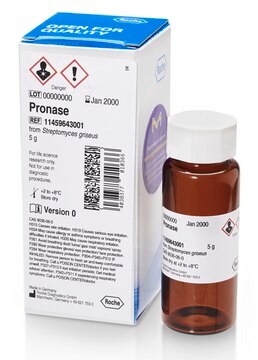About This Item
Produtos recomendados
Formulário
lyophilized powder
Extensão da rotulagem
~4 μmol per mL
técnica(s)
affinity chromatography: suitable
Matriz
Sepharose 4B
ativação da matriz
cyanogen bromide
ligação da matriz
α-amino
espaçador de matriz
1 atom
adequação
suitable for chromatography
temperatura de armazenamento
2-8°C
Procurando produtos similares? Visita Guia de comparação de produtos
Aplicação
L-lysine-agarose is used in protein chromatography, affinity chromatography and amino acid resins. L-lysine-agarose has been used to study mitogen-activated protein kinase (MAPK) cascades in abscisic acid (ABA) signal transduction pathways as well as to study the regulation of phosphorylation of tau protein in the brain.
forma física
Lyophilized powder stabilized with lactose and dextran
produto relacionado
Nº do produto
Descrição
Preços
Código de classe de armazenamento
11 - Combustible Solids
Classe de risco de água (WGK)
WGK 3
Ponto de fulgor (°F)
Not applicable
Ponto de fulgor (°C)
Not applicable
Equipamento de proteção individual
Eyeshields, Gloves, type N95 (US)
Escolha uma das versões mais recentes:
Já possui este produto?
Encontre a documentação dos produtos que você adquiriu recentemente na biblioteca de documentos.
P Saxena et al.
Investigative ophthalmology & visual science, 41(6), 1473-1481 (2000-05-08)
With age, human lens crystallins become more pigmented, oxidized, modified by ascorbate oxidation and advanced glycation end products (AGEs), and bind copper. The hypothesis was tested that the major AGE and ascorbylation product in the human lens, N(epsilon)-carboxymethyl-L-lysine (CML), has
V J Christiansen et al.
Arteriosclerosis, thrombosis, and vascular biology, 17(1), 164-171 (1997-01-01)
Deposition of the terminal complement proteins (C5b-9) on human endothelial cells can result in cell lysis or nonlytic alterations of cell function including procoagulant responses. Because regulation of fibrinolysis is a central endothelial function and because C9 contains a carboxyl-terminal
M B Furie et al.
Journal of cell science, 88 ( Pt 2), 161-175 (1987-09-01)
Monolayers of bovine microvascular endothelial cells (BMECs) grown on connective tissue derived from human amniotic membrane were used to examine the transendothelial migration of human neutrophils in vitro. Neutrophils placed above these cultures migrated in response to a chemotactic gradient
H H Nguyen et al.
The Journal of biological chemistry, 273(14), 7957-7966 (1998-05-09)
The particulate methane monooxygenase (pMMO) is known to be very difficult to study mainly due to its unusual activity instability in vitro. By cultivating Methylococcus capsulatus (Bath) under methane stress conditions and high copper levels in the growth medium, membranes
J Tao et al.
Proceedings of the National Academy of Sciences of the United States of America, 89(7), 2723-2726 (1992-04-01)
A single arginine residue within the basic region of the human immunodeficiency virus Tat protein mediates specific binding of Tat peptides to a three-nucleotide bulge in TAR RNA. It has been proposed that arginine recognizes TAR by forming a network
Nossa equipe de cientistas tem experiência em todas as áreas de pesquisa, incluindo Life Sciences, ciência de materiais, síntese química, cromatografia, química analítica e muitas outras.
Entre em contato com a assistência técnica






